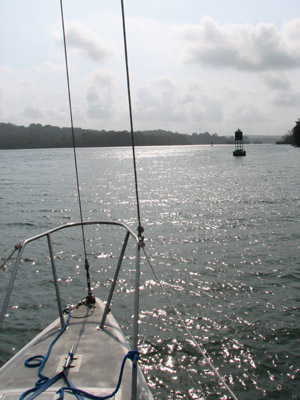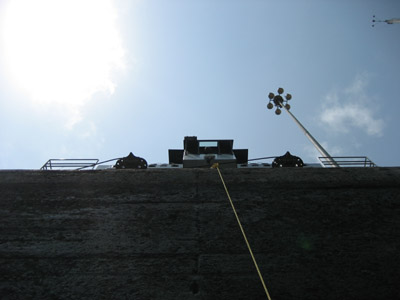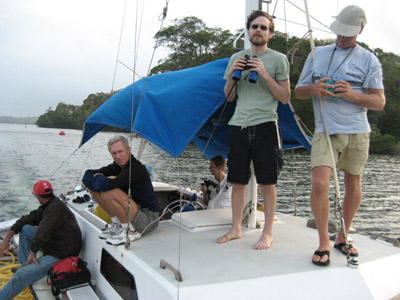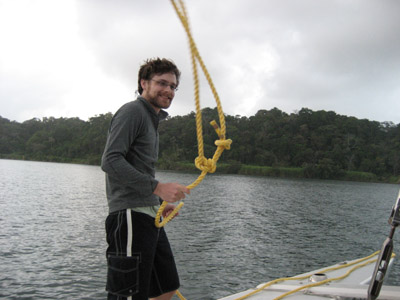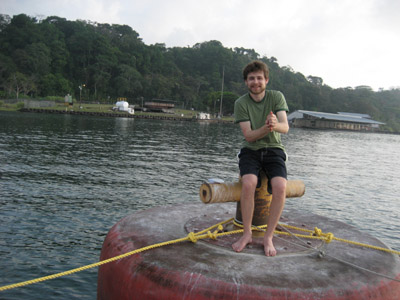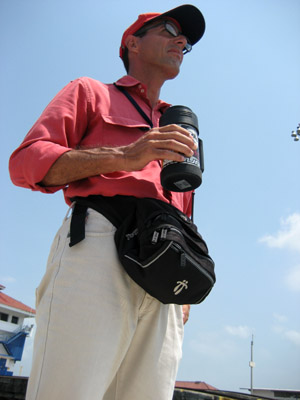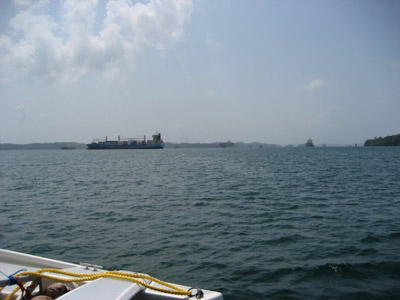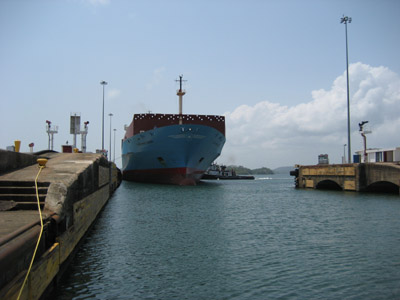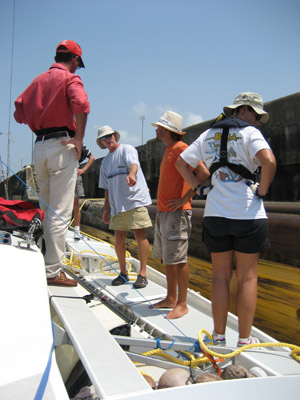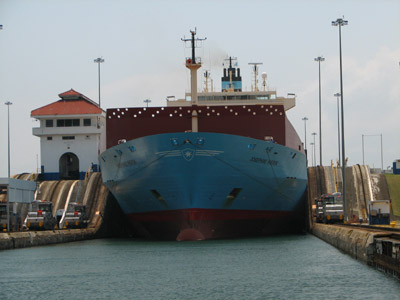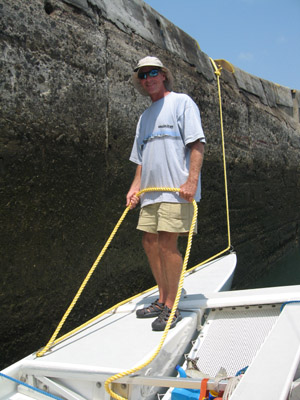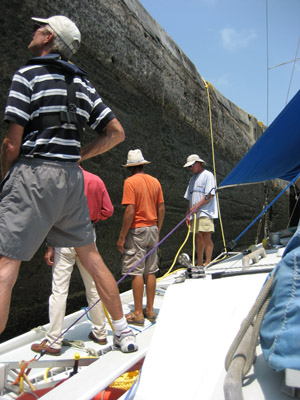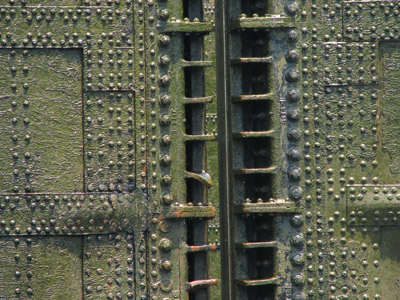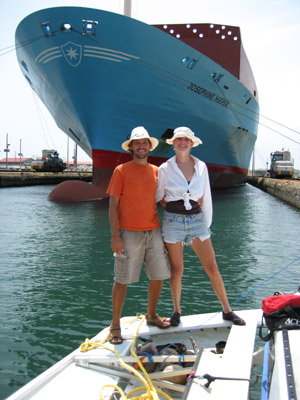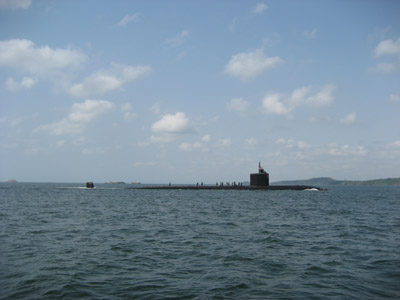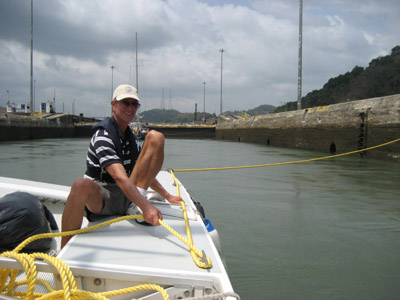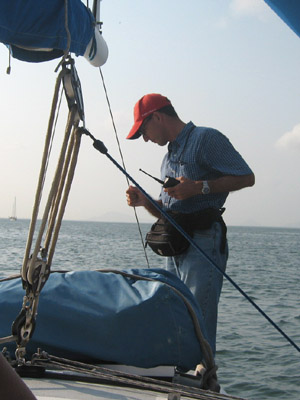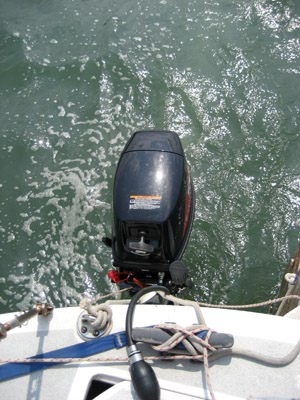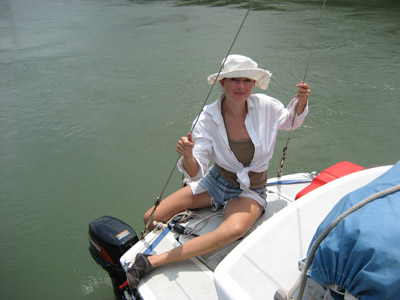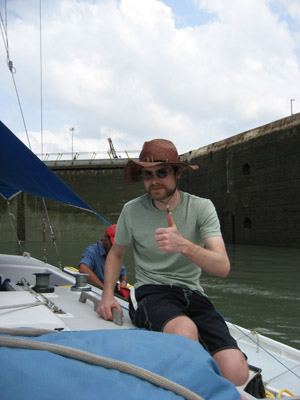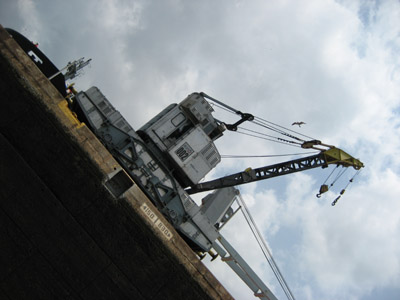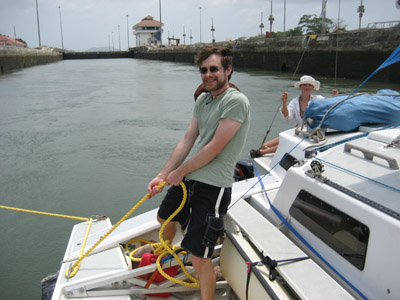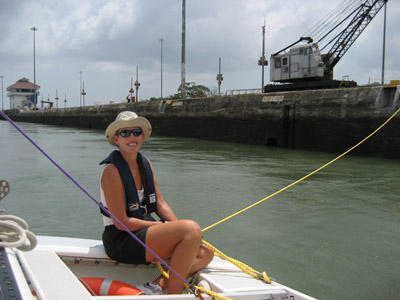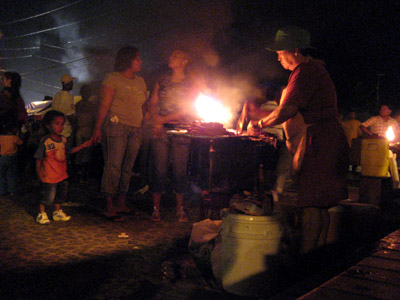The Crazy Frenchman of Portobelo
Thursday, March 8th, 2007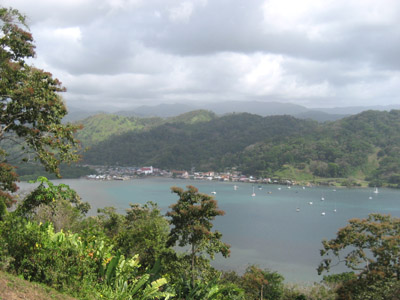
“You see that boat with the sails up? Don’t anchor near him; he’s crazy!” This was shouted at us from a small power yacht as we tacked up into the diminutive Portobelo bay, weaving in and out among the anchored boats while we selected a good place to settle.
We had noticed the boat with the sails up; it stood out with both the main and mizzen fully hoisted and we had already discussed ourselves dry of all possible explanations as to why this might be since he was clearly at anchor. We weren’t actually in any danger of anchoring near him anyway since we had chosen the quieter, northern side of the bay near the ruined fort but I guess the excitement spawned by recent events had everyone in the bay anxious and excitable. We wrote off Mr. Warning Man as just another cruiser zealot stricken with that annoying habit of needing to disperse advice to whoever is within earshot.
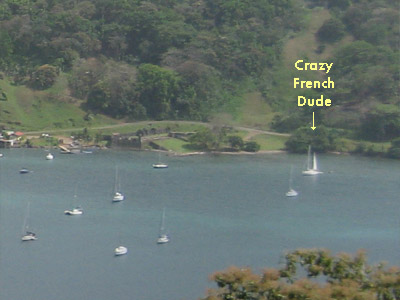
There were around 40 boats anchored in the Portobelo bay, which is to say, big city time after the deserted bend of the Rio Chagres we enjoyed the past few days. Smack in the middle of the bay was a 150-foot private power yacht, “Triton,” complete with fleet of matching white kayaks, a pair of lime-green jet skis, a red helicopter seated on a small landing pad aft of the bridge, and a handful of pert uniformed crew. After we ate dinner, we sat in the cockpit finishing a bottle of wine and enjoying the quiet night and full moon.
Around 7:30pm or so, someone’s voice came on the VHF cruiser hailing channel, “Attention the fleet, attention the fleet: The Frenchman is on the move!” Well, this was certainly an odd announcement. Frenchman? It didn’t take long for a chorus of clarification to ring out over the VHF, echoed around the bay from as the boats turned their radio volumes way up so they could go out on deck to watch. “Attention the fleet! Attention the fleet!” (A phrase that always amuses me although I have to admit, with 40 boats in one anchorage, ‘fleet’ is somewhat apt.) “The crazy man with the sails up has weighed anchor and is sailing through the anchorage!” (Now we figure out what’s going on—this is the guy the power boat was warning us about.) “Everyone, I suggest standing watch to see what he does because he already set two boats on fire.” (He what?!) Panache, one of the boats evidently set on fire seizes this opportunity to pipe up, “Yes, he is, um, mentally unstable and set my boat on fire yesterday.” (Whoa.) “Twice!”
By now we are passing the binoculars around and have the hand-held VHF turned on as well so we can eavesdrop on conversations taken off-channel. We can see that the boat with the sails up is moving through the anchorage at a speed of maybe one knot, sometimes less than that—there is very little wind this evening. Behind his sailboat by about two boat-lengths trail a couple of dinghies from very long painters. There is a blizzard of VHF static and chatter and as we scan the anchorage, everyone on a boat is standing out on deck watching the Frenchman with their binoculars. It’s all very exciting.
The Frenchman emerges from the southern cluster of boats and points his sailboat slowly for the north side, towards Triton. A clear voice rings out from the hand-held, “Large Power Yacht Anchored in Portobelo, Large Power Yacht Anchored in Portobelo, please be advised that there is a mentally unstable man headed in your direction!” A flurry of clarification follows: “I think they are called Triton.” “I think they monitor 16.” Then an audible click as every single boat in the anchorage changes their VHF channel to 16 to eavesdrop. Triton is successfully hailed. “Thank you very much Captain, we are on top of the situation,” comes the crisp reply. It now looks like the Frenchman is going to ram the big yacht. At a full 1 knot of speed. We can hear him shouting obscenities in French and sometimes English: “Ahss-hull!” We can see uniformed crewmembers running up and down stairs on Triton.
A minute or so later, he actually does ram the yacht. We hear intensified shouting and two flare-gun or small pistol shots. We see the boat pushed off the yacht and it slowly moves away from Triton as the yelling continues. There is more VHF activity and Panache is back on to commiserate, “Power Yacht Triton, Power Yacht Triton, this is the Good Sailing Ship Panache!” the tight British accent with a palpable note of hurt and indignation continues, “I’ll have you know I too was attacked by this vessel; that man aboard is totally out of his head—I mean to say he is unstable and can act unpredictably. He set my own vessel afire with gasoline not two days ago. I suggest keeping someone on watch at all times with him around!” Again the cool voice, “Thank you Captain, we’ve, uh, come to the same conclusion and I believe we have the situation under control.” Panache continues, “Well, I thank you for the words of encouragement and keep me posted as to that boat’s whereabouts, will you.” (As if Panache of all people wasn’t out on deck with the rest of us planted behind a pair of binoculars.)
Five minutes later, Triton pulled anchor and steamed out of the harbor and out of sight. The Frenchman weaved unsteadily off and finally ran aground on the south side of the harbor, where he stayed for the next half hour. “I believe the Crazy Man is aground!” “Good riddance!” Then people felt the need to fill in with gory details. “Is that black guy still on the boat with him?” (We found it very weird and somewhat disturbing that the Frenchman’s local friend is always referred to as “that black guy,” as nearly everyone here is black except for the gringo tourists.) “Well, they may have had a falling out after the black guy pushed him overboard.” (What the hell?! This was just getting weirder.)
At last, the Frenchman towed himself off the rocks with his own dinghy, pulled the sailboat back to where he started, and dropped his anchor. The VHF fell quiet with only a few peeps now and again from those unable to get their word in earlier: “Someone should cut his dinghy loose and then maybe he would be less of a problem.” “We ought to set HIM alight!” “No, what he needs, is someone with a gun to just take him out. It’s the only answer as far as I’m concerned.” I’m actually a little surprised at the viciousness of the radio chatter, but I guess I’m new to these parts.
The next morning we woke at dawn to find a solitary dinghy floating free in the bay; someone from one of the other boats went over to retrieve it and discovered it did in fact belong to the Frenchman. Not wanting to attract unwanted attention but unwilling to let a dinghy just drift off to sea, he tied it to a nearby wreck and split. Later that day, “the black guy” fetched the dinghy and brought it back. The Frenchman’s boat is now silent and I never see anyone out on deck ever, I just notice that sometimes the dinghy is gone or that it is back, or that his mainsail has come down—although never the mizzen. The boat hasn’t moved since.
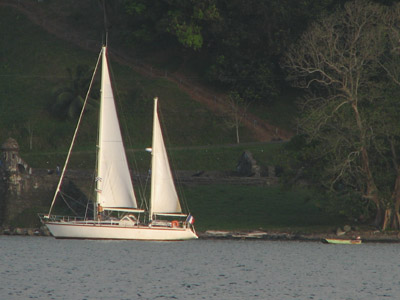
The Crazy Frenchman of Portobelo. Note that he is actually out on deck this time—a first—putting his mainsail back up. In addition to his national and Panamanian courtesy flags, he is also flying the flags for ‘Q’ (or the Quarantine flag), ‘N,’ and ‘C,’ which is probably code for “En garde! For tonight I strike!” At any rate, we’ll keep our radios on.
ADDENDUM
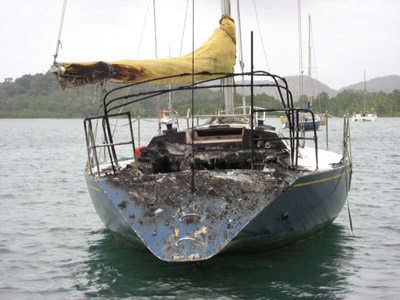
And strike he did. Around 4am this morning when the roosters and birds were just starting to make noise, I woke up to a radio blip thinking I heard the word ‘fire,’ so we popped out of the cabin to check things out. Across the anchorage, the nearest boat to the Frenchman was in flames. Major flames. A police car sat on shore with the lights flashing but as far as we could see, no other action was being taken. The Frenchman’s boat loomed nearby in the darkness, main and mizzen fluttering but otherwise silent. The victim was an uninhabited boat and so a nearby boater dinghied over with a bucket to put the flames out. Once the fire was out, the police left and no action was taken, as no action against the Frenchman has ever been taken thus far. Panama’s jurisdiction happily ends at the shoreline where crazy Frenchmen are concerned and the French embassy has also expressed little interest in rectifying the matter. As with Panache and Triton, there was no provocation whatsoever for the attacks and unfortunately, this boat is a total loss with the entire cabin inside burned and the decks spongy.
FURTHER DEVELOPMENTS It turns out that the boat was owned by an Italian expat (the rumor mill turns…) and the severity of the attack finally forced a little action. The Navy came and removed the Frenchman (yelling and screaming) from his boat just about an hour ago.
